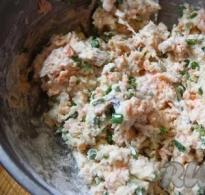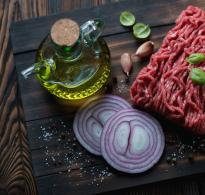Lemon cake. Lemon cake with zest and glaze - preparation for Easter according to a step-by-step recipe with photos Easter cake recipe with lemon juice
Tomorrow is Easter, and I just baked Easter cakes today. This time I took the recipe from the book “Encyclopedia of Orthodox Ritual Cuisine” :)
The cake turned out very tasty!! And it's quite easy to do.
First, dissolve fresh yeast in 100 ml of warm milk. If there are no fresh ones, then you can use dry ones in a ratio of 1 to 3, i.e. approximately 17-18 Also add 1 tbsp. Sahara. Stir and leave to rise. The mass should become airy.
Then add the rest of the warm milk, flour, a pinch of salt and mix thoroughly with your hands. The mass will be very dense.
Leave in a warm place. I put it in the oven, preheating it slightly. The dough will rise and become more airy and soft.
Add melted warm butter to the risen dough and stir. I stirred with my hands. The dough immediately transforms and becomes pliable and soft.
Beat the yolks with sugar.
And add along with the zest of one lemon. Stir with a spatula.
Beat the whites and add to the dough along with the raisins, stir gently.
Fill the molds about 1/3-1/2 full and leave to rise. As soon as the dough rises to the sides of the mold, place in an oven preheated to 180 degrees and bake until done. From about 25 minutes for small molds.
The dough turns out unusually airy, porous and very aromatic! (For the sake of experiment, I baked this in such a mold)
For decoration I use Swiss meringue. I never use raw eggs.
For meringue you need to take the weight of one protein and 2 amounts of sugar. Place the mixture in a water bath and heat to 60 degrees. For those without a thermometer, the mixture should become noticeably hot.
Then start beating with a mixer until a thick, white and shiny mass is obtained.
Lemon is perhaps one of the most not only famous, but also very useful citrus fruits, which has a number of beneficial properties. Its main advantage is considered to be the richest combination of substances necessary for our body: these are organic acids (malic, citric), vitamin C, vitamins B, P, A, saccharides, pectin, as well as salts of calcium, potassium, iron, phosphorus, magnesium. Moreover, the lemon peel will contain the most beneficial essential oil, which, in addition to its pleasant aroma, also has soothing and rejuvenating properties.
In cooking, lemon is also one of the most commonly used products. We invite you to prepare an unusually tender Easter cake with subtle lemon notes that will certainly captivate your guests!
To make Easter cake with lemon, you will need:
wheat flour (highest grade) – 1-1.3 kg
instant yeast - 1 pack.
chicken eggs – 6 pcs.
butter – 180-250 g
milk – 1 tbsp.
lemon – 1 pc.
sugar – 7-12 tbsp. l.
salt – 1 tsp.
saffron – 1 tsp.
raisins - to taste
powdered sugar – 200 g
confectionery topping
coconut flakes
How to make Easter cake with lemon:
1. Take the milk out of the refrigerator and heat it to room temperature (you can even warm it up a little). Pour salt, sugar and yeast into it, mix everything, add about 300 g of flour (be sure to sift the flour!). Mix again, cover with a lid and leave the prepared dough in a warm place. As soon as it rises well, we will knead the dough.
2. Meanwhile, prepare the remaining products. So, melt the butter over low heat (or in a water bath), and then let it cool at room temperature. We thoroughly wash the lemon, wipe it dry, and then grate the zest (only the yellow part) on a fine grater.
We sort out the raisins, rinse and pour boiling water over them for 5-7 minutes. Then rinse the raisins in cold water and dry them a little on a paper napkin.
Carefully separate one egg white into a separate container and place it in the refrigerator. Break the remaining eggs into a convenient bowl and shake them.
3. Now you can start preparing the dough. So, add raisins to the dough, 1 tsp. a spoonful of grated lemon zest and 1 tsp. saffron After this, add the eggs and melted butter. Mix everything and start adding flour little by little.
Now knead the dough and add enough flour so that the dough comes away from your hands and utensils. If you don't feel comfortable kneading it in a bowl, you can do it on the table, sprinkling the work surface with flour. The main thing is that your dough is well kneaded right away. Now we put it back into the bowl, close the lid, wrap it with a towel and put it in a warm place so that it fits well.
After the dough has doubled in volume, knead it again and leave it to rise again.
4. Grease the baking dish with butter or vegetable oil, and then fill it with dough (half, no more). We give the dough a little more time to rise (about 20 minutes), after which we send the form to an oven preheated to 180 degrees. If, during the baking process of the Easter cake, the dough on top begins to burn, then cover it with foil. We check the readiness of the Easter cake in the usual way - with a long wooden skewer or a splinter.
5. So, we take the finished cake out of the oven, let it cool a little and only after that take out the molds. At this time, we begin preparing the glaze. Beat the chilled egg white in a convenient container, to which we gradually begin to add powdered sugar (beat everything together until you get a thick and very stable consistency). At the end, add 1 tbsp directly to the glaze. l. lemon juice (can be from the lemon from which we removed the zest). Immediately grease our cake with the prepared glaze, and sprinkle it with coconut flakes and confectionery topping.
After trying a lot of recipes, I found this one and just love it! The Easter cake turns out very light, airy and melts in your mouth! I’ve been making this recipe for the second year now, but this year I decided to increase the quantity. If you don’t need that many cakes, just divide all the ingredients in half.
Let's get started:
Sift the flour and add the yeast.

Heat the milk (do not boil) and melt 600 grams of sugar and 600 grams of butter in it. Cool until it is warm (most importantly not hot).

Then pour the milk into the flour.

Important: if you use fresh yeast you will need 120 grams. And before adding to the flour, crumble and pour warm milk to cover, wait until the tremors dissolve completely. Then add to the flour along with the butter, sugar and remaining milk.
Knead the dough until it is smooth and no longer sticks to your hands or the edges of the dish (approximately 15 minutes).

Cover the container with a lid or towel (do not close tightly, air should flow into the dough) and place in a warm place.
The dough will rise for approximately 75-90 minutes (it should double in size).
During this period of time, you can grate the zest (Important! Grate it carefully, you only need the top of the zest, do not grate the white zest; it will give bitterness)
And if you want to add raisins or candied fruits, you can wash the raisins and cut the candied fruits if they are large. I personally made some with candied fruits.

Separate the yolks from the whites, setting aside two yolks for greasing.
I don’t have a large container for the dough, so I make it in two pans. And that's why I only have two.

When the dough has risen, beat the yolks with sugar (2 tablespoons of sugar for 8 yolks) and beat the whites into a thick foam and add a pinch of salt at the end.

Our dough has risen and add the yolks and sugar to it.

And proteins must be introduced gradually.

Important! Even if you think the dough is liquid or too sticky, DO NOT add flour!
Add zest (raisins, candied fruits) to the dough and mix thoroughly. If you want to add raisins, then you will need 300-400 grams.
I separately made a small pan of dough with candied fruits.

Place the dough in a warm place and cover.

The readiness of the dough is determined as follows: it should increase 2.5 times; when pressed with a finger, it will slowly level out. This will take 75-90 minutes.

Preparing the dough molds (I bought ready-made ones and greased them with butter)
Preheat the oven to 180 degrees.
Our dough has risen and we place it in the mold. Take the dough with a ball, knead it and fill it to a third of the volume of the mold and put it in a warm place for 15-20 minutes.

When the dough has proofed well, i.e. has increased in volume, brush with the reserved yolks and place in the oven for 40-50 minutes. The baking time depends on the size of the cake.

You can tell if the cake is ready by piercing it with a toothpick and if there is no dough left on it, then the cake is ready.
Decorate to your liking :)))

Last year I made half the ingredients and this is how many cakes I got.

Happy holidays!
Bon appetit! :)
Cooking time: PT00H06M 6 min.
step by step recipe with photos
Incredibly aromatic lemon cake will amaze your family and guests not only with its attractive appearance, but also with its most delicate taste. The citrus aroma will highlight the sweetness of the baked goods so brightly that you will want to make this dessert more than once this year and next. In the store, choose lemons that are not thick-skinned so that the white layer between the peel and the fruit is minimally thick. You can also add dried fruits to the dough: raisins, dried apricots, dried cherries, cranberries, etc. Don’t forget to let the dough rise 2 times so that the yeast ferments properly.
Ingredients

- 0.5–1 lemon;
- 200 ml milk;
- 30 g fresh yeast;
- 3 cups wheat flour;
- 6 chicken eggs;
- 100 g butter with a fat content of at least 72%;
- 1.5 cups sugar;
- 0.5 tsp. salt;
- 120 g raisins;
- a little vegetable oil to grease the mold
- icing and sprinkles for decoration
Preparation
 1. Heat the milk slightly, up to 30 degrees, in a saucepan or saucepan, turning on the heat on the stove to minimum.
1. Heat the milk slightly, up to 30 degrees, in a saucepan or saucepan, turning on the heat on the stove to minimum.
 2. Pour boiling water over the lemon and grate its peel on a special grater, then roll the fruit over the table and cut it, squeeze the juice from half the lemon.
2. Pour boiling water over the lemon and grate its peel on a special grater, then roll the fruit over the table and cut it, squeeze the juice from half the lemon.
 3. In a deep bowl or small basin, combine heated milk with fresh yeast, 3 tbsp. l. granulated sugar, salt, 1 cup sifted flour and lemon zest. Mix thoroughly and leave the dough for 30–40 minutes, covering the container with a scarf and moving it to a warm place.
3. In a deep bowl or small basin, combine heated milk with fresh yeast, 3 tbsp. l. granulated sugar, salt, 1 cup sifted flour and lemon zest. Mix thoroughly and leave the dough for 30–40 minutes, covering the container with a scarf and moving it to a warm place.
 4. Crack the eggs into the bowl of a food processor or into a bowl with high sides. Pour in the rest of the granulated sugar.
4. Crack the eggs into the bowl of a food processor or into a bowl with high sides. Pour in the rest of the granulated sugar.
 5. Beat at highest speed for about 4-5 minutes until fluffy foam forms.
5. Beat at highest speed for about 4-5 minutes until fluffy foam forms.
 6. Melt the butter, but not to a boil.
6. Melt the butter, but not to a boil.
 7. Pour melted butter, egg mixture, lemon juice into the risen, expanded dough and mix thoroughly. Add the rest of the sifted flour and dried fruits.
7. Pour melted butter, egg mixture, lemon juice into the risen, expanded dough and mix thoroughly. Add the rest of the sifted flour and dried fruits.
 8. Knead into a sticky, viscous dough. You can add citrus or vanilla flavoring to it.
8. Knead into a sticky, viscous dough. You can add citrus or vanilla flavoring to it.
 9. Grease a baking pan with vegetable oil and carefully place parchment paper around the edges to create a tall cake. Place the dough one-third the height of the paper. Leave in a warm place for about 40–50 minutes, covered with a towel or scarf. Then bake in the oven at 200 degrees for about 35 minutes.
9. Grease a baking pan with vegetable oil and carefully place parchment paper around the edges to create a tall cake. Place the dough one-third the height of the paper. Leave in a warm place for about 40–50 minutes, covered with a towel or scarf. Then bake in the oven at 200 degrees for about 35 minutes.
 10. Cool the finished cake, prepare the glaze according to the description on the label if you bought a pack, or according to the recipe on our website. Divide the frosting into 3 parts, adding yellow and green food coloring to two of them. Decorate the baked cooled Easter cake to your liking with both icing and sprinkles.
10. Cool the finished cake, prepare the glaze according to the description on the label if you bought a pack, or according to the recipe on our website. Divide the frosting into 3 parts, adding yellow and green food coloring to two of them. Decorate the baked cooled Easter cake to your liking with both icing and sprinkles.
On the eve of the bright holiday of Easter, I want to offer you an excellent alternative to the classic yeast cake.
My cake is prepared much faster and easier, and the taste is very original. Guests often think that it contains cottage cheese. :)
The recipe for this non-standard Easter cake appeared in my arsenal exactly a year ago, when I, as a nursing mother, followed a strict diet excluding dairy products, to which my daughter is allergic.
Besides, I don’t like classic Easter cakes...
So, I’m telling you my recipe.
To prepare a quick cake you will need the following ingredients: flour, sugar, 3 eggs, vegetable oil, 3/4 lemon, baking powder.

Wash the lemon, cut off the peel (optional), cut it into small pieces, remove the seeds, and grind the lemon with a blender. Reserve 1 tablespoon of lemon puree for the glaze.

Then beat 3 eggs with a glass of sugar.

Beat with a mixer at high speed until foam appears.

Add lemon puree. Sift the flour mixed with baking powder into the mixture.

Mix the dough with a mixer until smooth. Then pour vegetable oil into the dough.

Mix well again with a mixer. The dough turns out quite thick.

Place it in a cake pan. Fill the form 2/3 full, because the dough will rise during baking.

Place the baking sheet in an oven preheated to 180*C for 50 minutes. Next, evaluate the readiness of the Easter cake using a wooden stick. If after 50 minutes the inside of the cake is raw, you can reduce the temperature to 100*C and cook until done, checking every 5-7 minutes.
This time I baked the cake in a tall pan for 55 minutes at 180*C and 10 minutes at 100*C.
When the cake is ready, take it out of the oven and let it cool in the pan. The top of this Easter cake always cracks when baking, but this does not prevent you from decorating it beautifully.

While the cake is cooling, prepare the glaze. To do this you will need 1 egg, powdered sugar (60-80 g) and a tablespoon of the remaining lemon puree. Separate the white from the yolk.

Sift powdered sugar through a sieve. To make the glaze thicker and stronger, you need to take 100 g of powdered sugar. I wanted a less sweet glaze, so I took 60 g.

Add a tablespoon of the remaining lemon puree.

Beat everything with a mixer at high speed until foam appears. The glaze is ready.

After this, immediately apply the glaze to the cooled cake. Since I baked in a special paper cake pan, I removed it before applying the glaze.

After a couple of minutes you can decorate the cake. I used decorative sugar sprinkles.

This is the cake I got. With a hint of lemon... Very aromatic, tender, not dry and not wet... just what you need :)

Try it! Experiment for your own pleasure :)

Happy upcoming bright Easter holiday!
Cooking time: PT01H30M 1 h 30 min.






